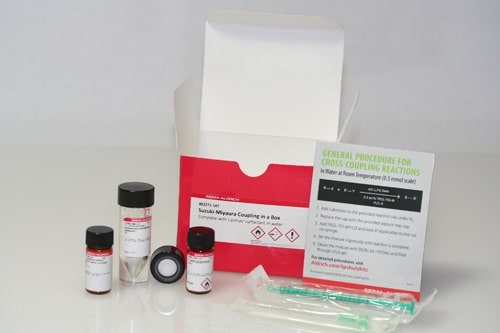Second-Generation, Designer-Surfactant Kits: Aqueous Reactions in a Box

Introduction
Reactions once dependent on organic solvents are now being performed in water to eliminate the contributions of organic solvents to chemical waste – and the methodology just became easier with next-generation designer surfactant kits. The kit chemistry is safe, gentle, and employs the amphiphile TPGS-750-M, which forms micelles in water that provide nanoreactors for processes that comprise water-insoluble organic substrates. In partnership with the Lipshutz Research Group, Aldrich Chemistry has developed the next generation of kits for ten water-friendly transition metal-catalyzed cross-coupling reactions. Kits contain premeasured catalysts, surfactant, and additives, as well as complementary written protocols to make your next reaction a straightforward one!

Advantages
- All-in-one, single-use kits for convenience
- Protocol-guided methodology
- Facile setup of traditionally solvent-dependent coupling reactions in water
- Facilitates sustainable and green-chemistry workflows
- Individual kit components also available
Protocols
Access protocols for each reaction in a box.
Innovation with Designer Surfactants
Performing transition metal-catalyzed processes in water and at room temperature is a significant challenge due to the insolubility of organic substrates. But it is also exceptionally attractive for green chemistry. Surfactant-enabled coupling exploits the micellar, lipophilic medium generated by amphiphiles in water to carry out the organic processes. Lipshutz and co-workers have been developing “designer” surfactants, such as TPGS-750-M (733857), to maximize reaction efficiency and yields. The lack of organic solvents and added energy (i.e. heating or cooling) lends to the green technologies for which Bruce Lipshutz was acknowledged in 2011 with the Presidential Green Chemistry Challenge Award.
ACS Webinet™
Designer Surfactants: How to Reduce Waste & Run Reactions in Water
Read more about TPGS-750-M in our Technology Spotlight!
Features of this technology in the Aldrichimica Acta:
1. Lipshutz, B. H.; Ghorai, S. Aldrichim. Acta, 2008, 41, 59.
2. Lipshutz, B. H.; Ghorai, S. Aldrichim. Acta, 2012, 45, 3.
3. Lipshutz, B. H.; Ghorai, S. Aldrichim. Acta, 2015, 48, 23.
References
如要继续阅读,请登录或创建帐户。
暂无帐户?